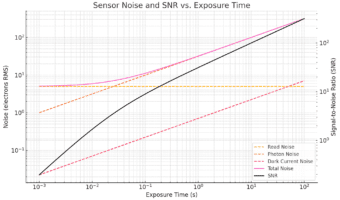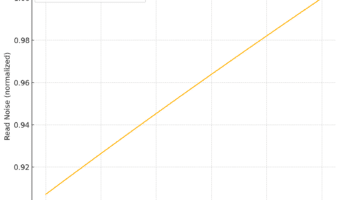If you wish to access the text content of The Last Word, you can do it here: https://chatgpt.com/share/682a0e4a-6714-800b-8b88-48b07545dc67 Limitations: Users must be ChatGPT Plus subscribers ($20/mo). Custom GPTs have no persistent memory per user. Each session is stateless unless the user keeps the window open and continues the same thread. Files users upload are… [Read More]
Calculating reach for wildlife photography
Bird and wildlife photographers are concerned with the reach of a camera and lens setup. Let’s define reach as the number of pixels per degree. If you’re a bird photographer, more is generally better. Here’s how to calculate reach given the focal length of the lens and the pixel pitch of the sensor. Let’s define… [Read More]
How Sensor Noise Scales with Exposure Time
When you increase the exposure time in a digital camera, you expect to collect more signal. But what happens to the noise? The answer depends on the source of the noise. Understanding how each one scales with exposure time helps you optimize your imaging strategy, especially in low-light or long-exposure situations. Let’s look at the… [Read More]
Dark Current in CMOS Sensors: Where It Comes From, and How Cooling Helps
In low-light or long-exposure photography, one of the most persistent sources of unwanted signal is dark current: thermally generated electrons that accumulate even in total darkness. Unlike read noise, which is largely constant from frame to frame, dark current grows with exposure time and varies from pixel to pixel. Dark current is the rate at… [Read More]
What cooling can, and can’t, do for CMOS read noise
Cooling a CMOS sensor reduces noise. But which noise? By how much? And is it worth the effort for your application? Let’s break it down by examining what cooling affects — and what it doesn’t — in the readout chain. What Do We Mean by “Read Noise”? Read noise includes all non-random and random noise… [Read More]
- 1
- 2
- 3
- …
- 577
- Next Page »



